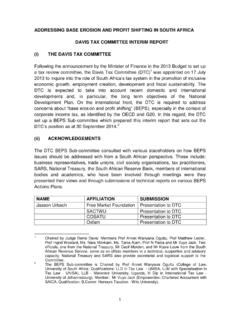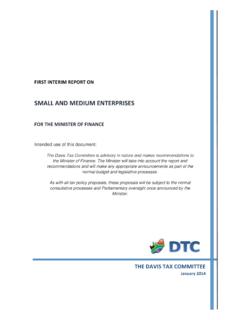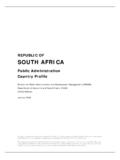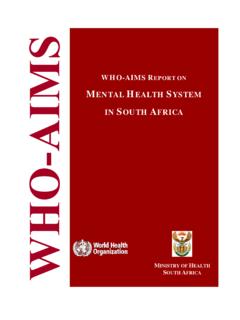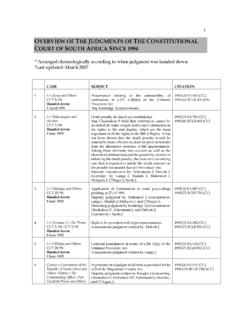Transcription of South Africa - Tax Com
1 Document of the World Bank Report No: AUS12595 . South Africa Country-level fiscal policy notes Sector Study of Effective Tax Burden & Effectiveness of Investment Incentives in South Africa -Part I . June 2015 . AFCS1 Africa .. Document of the World Bank .. Standard Disclaimer: . This volume is a product of the staff of the International Bank for Reconstruction and Development/ The World Bank. The findings, interpretations, and conclusions expressed in this paper do not necessarily reflect the views of the Executive Directors of The World Bank or the governments they represent. The World Bank does not guarantee the accuracy of the data included in this work. The boundaries, colors, denominations, and other information shown on any map in this work do not imply any judgment on the part of The World Bank concerning the legal status of any territory or the endorsement or acceptance of such boundaries.
2 Copyright Statement: . The material in this publication is copyrighted. Copying and/or transmitting portions or all of this work without permission may be a violation of applicable law. The International Bank for Reconstruction and Development/ The World Bank encourages dissemination of its work and will normally grant permission to reproduce portions of the work promptly. For permission to photocopy or reprint any part of this work, please send a request with complete information to the Copyright Clearance Center, Inc., 222 Rosewood Drive, Danvers, MA 01923, USA, telephone 978-750-8400, fax 978-750-4470, All other queries on rights and licenses, including subsidiary rights, should be addressed to the Office of the Publisher, The World Bank, 1818 H Street NW, Washington, DC 20433, USA, fax 202-522-2422, e-mail Document of the World Bank SUMMARY OF ACRONYMS AETR Average Effective Tax Rate GDP Gross Domestic Product ETR Effective Tax Rate DTI Department of Trade and Industry FDI Foreign Direct Investment IDZ Industrial Development Zones IFC International Finance Corporation IMF International Monetary Fund CIT Corporate Income Tax VAT Value-Added Tax METR Marginal Effective Tax Rate PIT Personal Income Tax SARS South African Revenue Service SEZ Special Economic Zone SME Small and Medium Enterprises WBG World Bank Group Document of the World Bank TABLE OF CONTENTS I.
3 EXECUTIVE SUMMARY .. 8 II. INTRODUCTION .. 12 III. ANALYSIS OF THE MARGINAL EFFECTIVE TAX RATES IN South Africa .. 15 Overview of METR methodology .. 15 Summary of the Marginal Effective Tax Rate Analysis for South Africa .. 18 South Africa and International comparisons of METRs .. 29 Conclusions and recommendations from the METR analysis .. 31 IV. DETAILED METR ANALYSIS FOR SELECTED SECTORS .. 34 Manufacturing .. 34 Agriculture .. 40 Mining .. 42 53 Conclusions and Recommendations for the detailed sector analysis .. 56 ANNEX 1: The Terms of Reference for 2014 Study of Marginal Effective Tax Rates .. 58 ANNEX 2: The Theory of Marginal Effective Tax Rates and Average Effective Tax Rates .. 59 ANNEX 3: METRs for Capital and Labor .. 63 Tables Table 1: Principal taxes and non-tax parameters used in the METR calculations 19 Table 2: Special Tax regimes for capital investment for the different sectors 20 Table 3: METR model parameters and assumptions in this report versus the 2006 report 21 Table 4: Marginal Effective Tax Rates on Capital: South Africa 23 Table 5: METR on labor for major sectors in South Africa 25 Table 6: METR on labor and capital (Production) 26 Document of the World Bank Table 7: METRs under different Debt-Asset ratios for South Africa 27 Table 8: Debt-Asset ratios for the Euro-area (2007) 28 Table 9: Economic vs.
4 Tax Depreciation (without tax incentives) for Sectors 28 Table 10: METRs in South Africa and around the World 31 Table 11: METR for the Manufacturing Sector 38 Table 12: METR for SMEs 39 Table 13: 12I Tax Incentives and its effect on the User Cost of Capital for Manufacturing 40 Table 14: METRs for Agriculture 42 Table 15: METR Analysis for mining Gold 46 Table 16: METR for the Mining Sector (based on AFS 2013) 47 Table 17: Royalty Rates 2010-2013 48 Table 18: METRs for the Tourism Sector 52 Table 19: METRs for the Financial Sector 54 Table 20: METRs for the Services Sector 55 Figures Figure 1: South Africa s revenue performance and fiscal deficit in an international perspective .. 13 Figure 2: South Africa s revenue performance and debt burden in an international perspective .. 13 Figure 3: South Africa : METRs in Manufacturing (2013) international comparison.
5 30 Figure 4: Sector contribution to Gross Fixed Capital Formation, 2013 .. 34 Figure 5: Sector contribution to employment, 2013 .. 35 Figure 6: Value of Agricultural Exports .. 41 Figure 7: FDI into Mining & quarrying .. 44 Document of the World Bank Figure 8: Growth in the Tourism Sector Relative to other Sectors .. 50 Figure 9: Direct and Indirect Impact of the Tourism Sector Relative to Other Key Sectors .. 51 Boxes Box 1: An illustrative example of METR .. 16 7 Acknowledgments The World Bank Group (WBG) team that prepared this report was led by Catriona Purfield, Program Leader, Macro-fiscal Management Global Practice (MFM GP), and comprised of Sebastian James, Senior Tax Specialist, Trade and Competitiveness Global Practice (T&C GP), who was the lead author of this report; Kobina Daniel, Senior Operations Officer (T Guillermo Arenas, Economist (T Phindile Ngwenya, Research analyst (MFM GP), and Ada Jansen, Associate Professor, Department of Economics, Stellenbosch University.))
6 The report was prepared under the oversight of Asad Alam (Country Direct, AFCS1) and Shan Gooptu (Practice Manger, GMFDR) and Mark Roland Thomas (Practice Manger, GMFDR) and was peer reviewed by Daniel Alvarez (GGODR), Anne Brockmeyer (GMFDR), Rong Qian (GMFDR) and Richard Stern (GTCDR). The mission wishes to express its gratitude to the Davis Commission, National Treasury, REDI, SARS, Statistics South Africa , the Department of Trade and Industry and representatives of the private sector and all the visited agencies for their collaboration and availability. The mission also wishes to thank those who provided feedback on the report and participated in the workshops conducted on the preliminary findings of the report. The mission also benefited from the South Africa World Bank Country office support in terms of logistics and meetings scheduling.
7 8 Sector Study of Effective Tax Burden and Effectiveness of Investment Incentives in South Africa -Part 1 I. EXECUTIVE SUMMARY 1. This report tries to address the question whether the tax system especially tax incentives are effective in reducing the burden on investment and if these lower burdens are translating to more investments. Part 1 of the report, presented here, shows how the tax system impacts Marginal Effective Tax Rates (METRs) on capital investment. It calculates the METR on capital and labor for the major sectors of the South African economy. The second part of the report, which will be issued separately in the coming months, aims to use firm level information to calculate the Average Effective Tax Rates1 of the major sectors and the elasticity of investment to the user cost of capital which captures the burden of the tax and non-tax parameters on the cost of 2.
8 This report updates the 2006 FIAS study of the Marginal Effective Tax Rates (METR) for the principle sectors of the South African economy called South Africa - Sector Study of Effective Tax Burden. 3 The METR is a measure of the burden of tax on the marginal investment for a profit maximizing firm and determines the scale of a project: a higher METR means small size projects and fewer investments. As a result, the METR is an important parameter to keep in mind when designing tax policy. This report also augments the quantitative METR estimates by sector with a qualitative analysis based on discussions with investors in key sectors on the tax and non-tax barriers to investments. It is hoped that this report will help the Davis Tax Commission to shed light on the impact of the tax system on investments in South Africa .
9 3. This report improves on the 2006 methodology along several dimensions. We use South Africa specific parameters in the METR model, mainly with respect to the actual asset structure and leverage ratios of each sector. We also cover a wider range of sectors. Using South African specific parameters brings a richer and more accurate set of information of the various assets, their economic life, and their different composition across sectors to the METR calculations. In addition, this study adds calculations of the METR on labor which allows us to provide a more comprehensive assessment of the impact of the total tax system on capital and labor used by firms. At the request of the Davis Tax Commission the methodologies and tools developed by this study have been passed onto South African policy makers through a series of workshops which will allow them to become integrated into the regular policy making process of the government.
10 The main conclusion arising from the report is that: 1 The AETR measures the average tax burden on overall investment and is important for locational decisions of firms and hence an important determinant for FDI. 2 The second part of this study uses firm level data to see how firms are responding to lower burdens on investments as measured by their user cost of capital. 3 Foreign Investment Advisory Services (FIAS) a joint service of the World Bank and the International Finance Corporation (IFC) conducted a study of marginal effective tax rates in five key sectors of the South African economy. 9 4. South Africa s METR is internationally competitive. For manufacturing it ranks 58th out of 95 countries and the analysis suggests that the tax system is not a major deterrent to investment.
